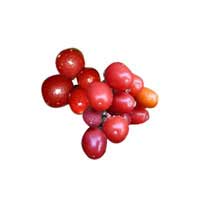 Full List of Fruits
Full List of Fruits  Lime berry fruit
Lime berry fruitLime berry
![]() Introduction of Lime berry fruit
Introduction of Lime berry fruit
Scientific name - Triphasia trifolias
Commonly known as lime berry, Triphasia trifolia is an evergreen shrub which is a species of Triphasia in the family Rutaceae. This evergreen shrub is indigenous to tropical southeastern Asia in Malaysia, the Philippines and possibly elsewhere. Having said that, they are very close relatives of citrus! It grows up to 3m (9ft 10in). The flowers of the tree are hermaphrodite means it has both male and female organs. The leaves of this spiny evergreen shrub are trifoliate, glossy dark green and every single leaflet is 2-4 cm long and 1.5-2 cm broad. With the flowers having three petals, they are white in color and 10-13 mm long and 4 mm broad. Sharing the same features of a small citrus fruit, the fruit is a red, edible hesperidium which is 10-15 mm in diameter. With a flavor that's reminiscent to sweet lime, the fruit flesh is pulpy.
![]() Nutritional Value of Lime berry fruit
Nutritional Value of Lime berry fruit
| Vitamins | value | % |
| Sodium | 85mg | 4% |
| Potassium | 45mg | 1% |
| Total Carbohydrate | 17g | 6% |
| Dietary Fiber | 0g | 0% |
| Sugars | 17g | |
| Protein | 1g |
The leaves of the tree serve dual purpose, seeing that they are used in cosmetics; they are also used for an aromatic bath. Lime berries on a shrub might not look a large amount; however they are edible and full of flavor. The tangy fruit when ripen gives out a very sweet taste and they are used to make jams, jellies and other preserves. The small fruit is also used to make a fragrant sweet tea.
The leaves of the tree are used for treating diarrhea, colic and skin diseases. Apart from that, fresh crushed leaves, when applied to the scalp, acts as a responsive medication to dandruff. They are also used for coughs. The fruit is generally used for sore throat and cough. The fruit can be cooked in both water and sugar; in general, they are used as remedy for coughs to loosen phlegm.
It is predominantly cultivated for the edible fruit that is produced. In addition, it has also been widely introduced to other subtropical to tropical regions of the world and has become naturalized (grow naturally) on a number of islands in the tropical Pacific Ocean. Typically it is planted as hedge or as specimen plant in the gardens. With that said, it is quite suitable for growing as bonsai. With a generous amount of compost, it prefers a moderately heavy loam and a sunny position. It can't be put up with winter wet and they are hidebound of water logging. Just about all parts of the plant are aromatic and new plants are raised from seed. They can tolerate only mild cold and requires great protection during the winter season. In order to ensure better germination, it requires immediate planting.


















